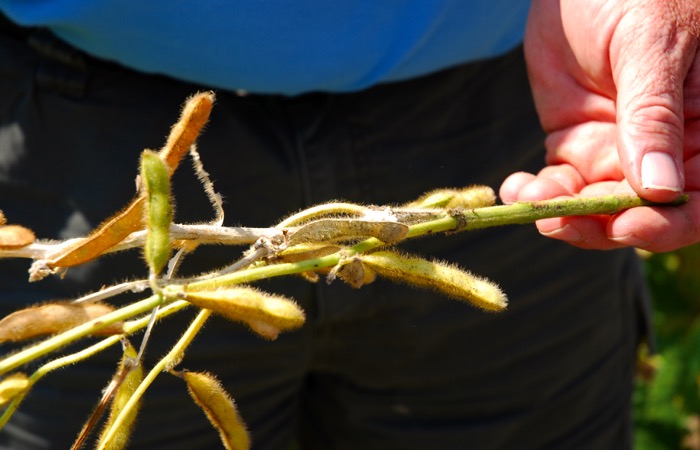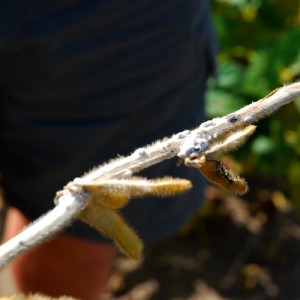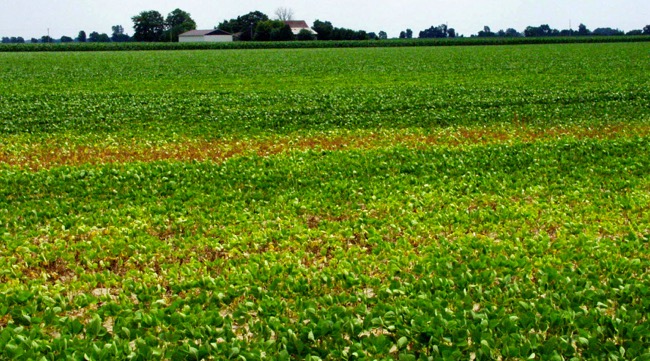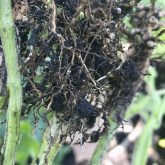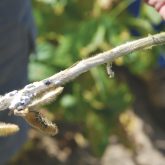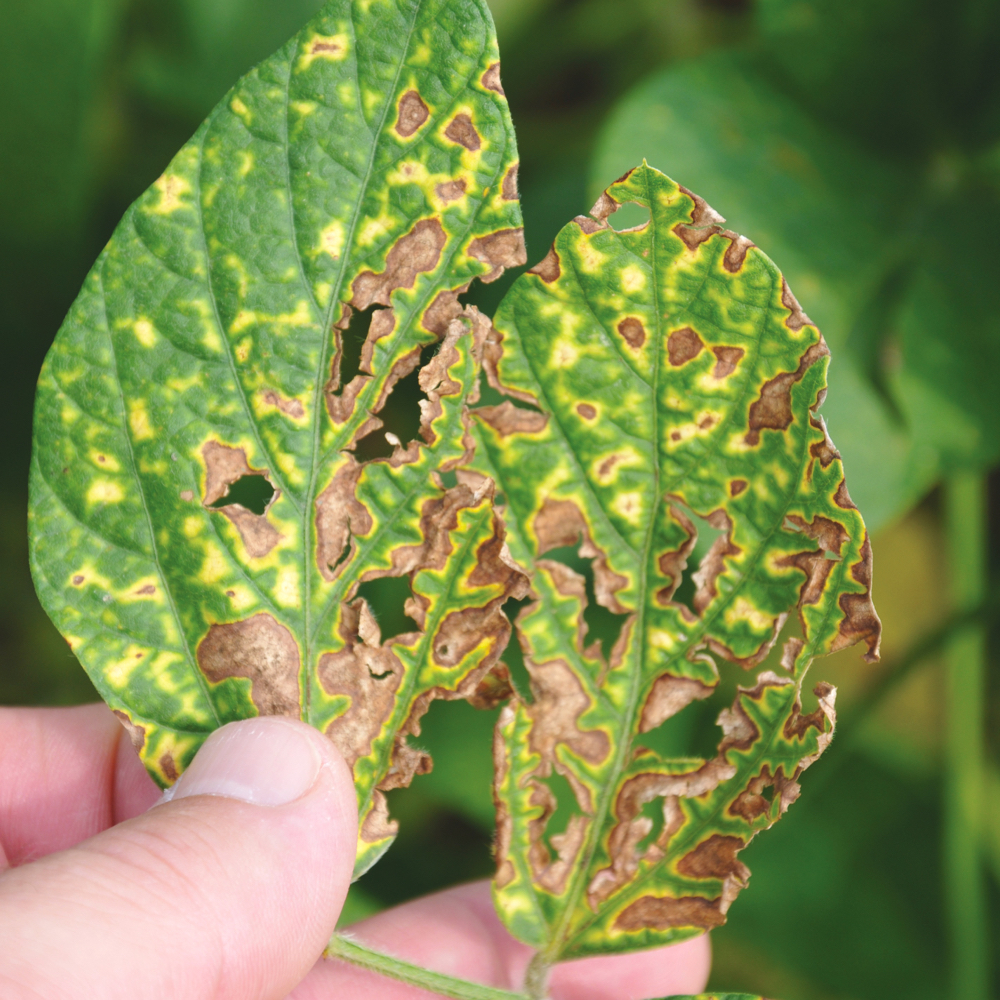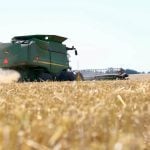There’s only one word to describe the outlook for soybeans in 2015. It’s “more.” With a reasonable spring, Eastern Canada’s soybean crop may hit an amazing 3.25 million acres.
But acreage isn’t the only number that may be up. We’re also likely to see more fields with second-year and some with third-year soybeans.
Then, if the predictions hold true, we’ll also see more white mould (sclerotinia) and sudden death syndrome (SDS).
That’s bad news our diseases are on the move. White mould is usually ranked as the biggest yield robber in eastern Ontario and western Quebec, but last year saw it become a bigger issue even in the southwest. SDS was seen in more growing regions too, and in greater severity.
Read Also

Sensing the soil: Root cell research finds ‘stress hormone’
Research into how root cells react to soil stressors could help plants better adapt to changes in their climate.
And soybean cyst nematodes (SCN) remained a considerable yield robber, not only across southern Ontario, but also farther east in the province as well.
Of course, Phytophthora root rot and Pythium damping off should never be ignored, wherever you are.
In other words, more regions are seeing more risks, and just about every farm needs to be on the alert in order to ward off a series of major threats.
Public and private agronomists are all looking at a tough 2015. Diseases were a problem last year, they say, but with an increase in soybean acres — along with more continuous soybeans — that trend is expected to continue, if not intensify.
“White mould, sudden death syndrome, soybean cyst nematode, the root rots and seedling diseases will be some of the biggest ones there,” says Albert Tenuta, field crops pathologist for the Ontario Ministry of Agriculture, Food and Rural Affairs. Tenuta adds that the threats are compounded by one of the key management tools to drive yield upwards — earlier planting into cool, wet soils.
White mould
Tenuta calls white mould “the most fickle disease” facing growers, but it’s also the most frustrating from an extension and research perspective. Inoculum is often present, but in order to thrive, the disease requires very specific environmental conditions, particularly for moisture and temperature. In 2014, there were some exhibitor plots at Canada’s Outdoor Farm Show with visible symptoms of the disease.
“In the years where we have cooler-than-normal and wet conditions, we see what can happen with white mould,” says Tenuta. He notes that many producers have all but forgotten how destructive white mould can be and how it can impact yield. “We have a lot more sclerotia left on the soil surface and in the upper two inches of the soil profile, and those are the most critical within a season for developing the spores,” Tenuta says. “They’re the ones that will cause you problems. Anything below two inches will remain buried and won’t germinate or develop into the apothecia and then the spores — they’ll just stay there.”
But surely, a grower might say, the conditions that made 2014 such a bad year for white mould aren’t likely to repeat in 2015. That’s true, but Tenuta points out that the inoculum load is that much greater, particularly in fields with beans on beans or beans on beans on beans, and this will increase the risk. And unfortunately, in no-till scenarios, those sclerotia are ready to spring into life within two inches of the soil surface.
So, would 2015 be the year for some light or moderate tillage to prevent those pathogens from developing?
Not necessarily, says Tenuta. Discing or cultivating the soil in the spring might just as easily bring any buried sclerotia back to the surface. And even if you end up with fewer sclerotia up where they can cause trouble, there may still be enough to create a serious risk.
The only way to really break the cycle is to maintain rotations — which is a challenge given the current pricing cycle.
“It goes back to all of these different diseases, and one of the most important things from an integrated pest management (IPM) standpoint is variety selection,” says Tenuta. “What growers do in the winter cannot be taken for granted. Planning is critical to a successful growing season — and variety selection is the most important.”
Understanding white mould pressure from field to field is paramount, because that’s how growers will be able to select the right variety for those fields. There’s no genetic resistance to white mould incorporated into current soybean germplasm or varietal lines, only tolerance to the disease. Tenuta is quick to point out that there are also pre- and in-season treatments that have not been available to growers in the past, including biologicals that can be applied pre-plant that colonize and disrupt the sclerotia, plus newer in-season treatments that are being developed.
“We can often get some degree of control or suppression of white mould but we can’t get rid of it,” says Tenuta, adding that knowing which fields are susceptible is the first line of defence. “It comes down to genetics and germplasm and variety selection. I can’t overemphasize the importance of variety selection for the specific needs for your specific fields.”
The frustrating part of white mould is that unlike some other diseases or insect infestations, it doesn’t have a visual threshold that can be used for scheduling a spray. Once the disease is visible in a field, that field is infected and it is beyond the point where it can be treated via a chemical application, which becomes little more than revenge spraying. What’s more frustrating is that many of the measures that promote higher yields, such as higher plant populations, higher fertility and narrow rows, can provide the right microclimate within the canopy for the disease to flourish.
“The key in 2014 was that optimal environmental conditions stayed much longer than normal,” says Tenuta. “In most years, we end up with hot, dry conditions by the middle of July and into August, and even though we have white mould starting, it doesn’t spread any further. In 2014 though, even with a preventive fungicide application (at R1 or R2) and even some later applications (around R4 or R5) the extended fall seemed to help the diesease. But Tenuta still says those early applications are something to consider, particularly if you have the higher-risk situations.
Sudden death syndrome
According to several sources, sudden death syndrome is another emerging challenge for growers, and 2014 was another year of marked increases in the disease, particularly in southwestern Ontario. For the coming year, SDS may see another jump in area or in intensity, given the rise in acres and the increased frequency of second- and third-year soybeans.
“Again, variety selection is important and soybean cyst nematode resistance is important,” reminds Tenuta, drawing a link between SDS and soybean cyst nematode, which he often referred to early in 2014 as well. “And unfortunately, with SDS, it’s often our best fields that are showing the disease. It’s the same thing with white mould; high-fertility, high-growth conditions promote white mould, and the same things happen with SDS. The good fields, the high-productive fields are often the first to show SDS and often see the most damage as well.”
Like white mould, SDS increases as growers continue to plant earlier into colder soils in an effort to push maturity on their soybeans.
It’s not that early planting is a bad idea, just that the risk of infection — and from more diseases — increases. With SDS, notes Tenuta, it’s cooler, wetter conditions, typically within the first two or three weeks of planting, that are very important to establishing the disease. It’s at that point the disease pathogen will colonize the roots and then wait until stress conditions occur or until later in the growing season when the typical SDS above-ground symptoms start to appear. Even in a good growing season, Tenuta says, the disease can cause damage and yield loss.
It’s all the more reason for growers to know their fields and to understand the disease species that are present. Only then, Tenuta says, can they respond with the right integrated pest management strategy, including variety selection.
“Seed treatments are also important,” adds Tenuta. “Fungicide seed treatments are a necessity for soybean development and for maximizing yields, and we must not underestimate their importance.”
Tenuta has been working with U.S. researchers in the north-central soybean research program to look at sudden death syndrome as well as seedling disease, and also with the Grain Farmers of Ontario through a Growing Forward 2-funded project. They’ve noticed that with sudden death syndrome in particular, yield losses can run as high as five to six bushels per acre. And that’s just with normal planting dates.
In testing a new active ingredient seed treatment, however, Tenuta says the joint Canada-U.S. research project has found it gives a yield boost of three to four bushels per acre, even where the crop was planted at the end of April under cool, wet conditions into soils with a high SDS.
“There are some good new tools coming down the pike that growers will be able to integrate into their management system, as well,” Tenuta says.
Soybean cyst nematode
A long-standing pest of soybean fields, particularly in southern Ontario, soybean cyst nematode (SCN) continues to be a perennial leader in the “yield-robbing” category. In spite of standard sources of resistance (i.e. PI 78877 and the Peking sources) incorporated into varieties, the troubling issue with this disease pest is that there are some new Heterodera glycines (HG) types and nematode populations that are putting pressure on existing resistance sources.
In 2014, there were some resistant varieties that were more susceptible to SCN than in the past.
The other concern with SCN is that it is not as environmentally dependent as other diseases. Tenuta says regardless of weather or climatic conditions, there will always be some level of SCN infection, with consequences for fields. If it’s a highly stressed year, then even at lower populations there will be more potential for damage. In some good years, there may be little or no above-ground symptoms, but that doesn’t mean the damage isn’t being done.
Phytophthora and Pythium
Of the prevalent diseases in soybeans these days, Phytophthora root rot and Pythium damping off are the most environmentally dependent. At the present time, Phytophthora resistance is fairly well entrenched, but Pythium is showing signs of developing a more diverse threat. Within the past decade, there were only one or two Pythium strains; now researchers are isolating nine or more from different varieties.
Even if resistance to Pythium is lacking in soybean germplasm, there are good seed treatments available, including Metalaxyl and Metalaxyl-M. Yet Tenuta says there are also signs of resistance to those active ingredients beginning to creep into fields.
“As our GFO-funded project has shown, we’re seeing all of these disease organisms get smarter and have the ability to adapt to our management practices,” Tenuta says, speaking specifically of Pythium but referring in general terms to all of the diseases mentioned above.
Take-away message
Again, Tenuta says he can’t overemphasize the need for preplanning and for farmers to know their fields. The work done in the middle of winter will pay its own rewards, he adds, especially if rotations are being sidetracked with back-to-back, or back-to-back-to-back soybeans. It is paramount to review field notes from previous years, to map out parts of fields where certain diseases may be a problem, and to diversify those varieties, perhaps planting five different varieties across five different fields rather than opting for a favourite or “workhorse” variety.
It’s also worth noting that these disease issues continue to develop and diversify, becoming part of the “normal” farming landscape. There is no single silver bullet solution, says Tenuta, and there is no single active ingredient that can be called upon to solve every issue, be it a disease, or a weed species or insect pest.
“We never had that (silver bullet) in the first place, but the seed is now being challenged by a more diverse pathogen population,” says Tenuta. “We’re going to have to depend on different active ingredients to hit those little niches of what we’re missing. It’s going to become more complicated in the future.”
This article was originally published in the February 2015 Soybean Guide


